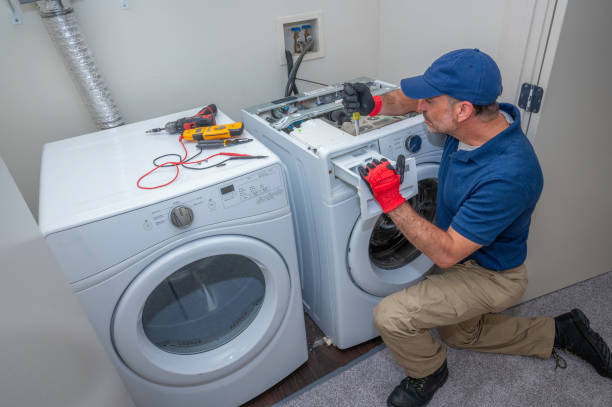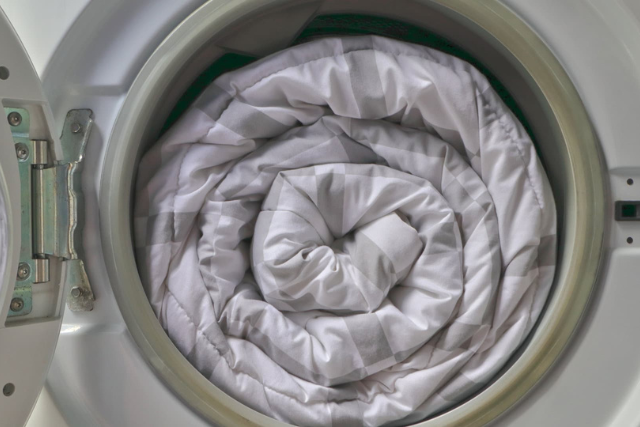How to Improve Your Washing Machine’s Performance & Efficiency

Every laundry routine needs a dependable washer that can handle all sorts of fabrics and stains without wasting energy or compromising cleaning power. Whether you’re dealing with bulky items like comforters or a single load of delicate garments, a well-chosen machine and the right wash cycles can streamline your day-to-day tasks. This guide explores key factors like the difference between top-load and front-load washers, how to reduce water per load, and the advantages of investing in high-efficiency models. Discover how to maintain optimal temperature, harness smart features, and keep your washer in peak shape.
Understand the Difference Between Front-Load and Top-Load Washers
Different types of washing machines suit varying household needs. Front-load washers position the drum horizontally, using gravity to tumble clothes. A front-loading washing machine generally consumes less water and offers better energy efficiency. By contrast, top-load washers are loaded from above, with an agitator or impeller in the center. Each type of washing machine has pros and cons—while front-loading washers excel at larger loads, a top-loading washer may offer easier access, especially if you have limited floor space or prefer a more straightforward design.
Explore Water and Energy Usage in Washers
Modern washing machines can significantly influence energy bills and water consumption. Look for Energy Star or high-efficiency machine labels to ensure energy efficient operation. Some advanced washers track water supply usage, temperatures, and spin speed to tailor the cycle. Energy consumption is often measured in kWh of energy per load of laundry. Opting for a washer with auto temperature control or an automatic temperature control feature helps optimize hot water, cold water, or mid-range cycles for different types of fabrics.

Examine the Significance of Washer Features
From smart features like WiFi connectivity to preset proportions in the detergent dispenser, helpful washing machine features can transform the way you do laundry. Customizable settings, specialized cycle options, and automatic dispensers let you handle kinds of stains more effectively. Additionally, higher spin speeds reduce dry time and can even decrease your overall energy usage.
Compare Agitators and Impellers
Traditional top-loading washing machine models often have a central agitator that rotates clothes vigorously. This can be effective at Stain removal but sometimes harsh on delicate items. Newer impeller washer designs (also called a 1 Removable Agitator or 2-in-1 Removable Agitator) use a low-profile disc to move water and fabrics, providing gentleness on fabrics while achieving adequate clean laundry. Some washers let you swap between a central agitator and an impeller, giving you the best of both worlds for different types of fabrics.
Determine Washer and Dryer Capacities
Capacity is key: a single load in a high-capacity washer might handle 8-pound load or more, reducing total wash times and loads of laundry each week. Inspect the drum capacity (in cubic feet) to ensure it suits your household’s needs—oversizing might lead to wasted water, while an undersized model could require multiple washes. When selecting a Dryer Pair, match washer capacity with the dryer models for balanced dry time and cleaner clothes.
Invest in High-Efficiency Washing Machines
High-efficiency models offer energy efficient performance, shorter cycle times, and fewer resources spent per load of laundry. Many Energy Star-rated washers (especially Front-Load High-Efficiency or High-Efficiency Top Load Washer) reduce energy per load and water per load. While the initial purchase price might be higher than standard models, the long-term energy savings often compensate, lowering your billing cycle expenses. Many new washers come with Steel or Stainless steel drums for durability and better cleaning performance.
Regular Maintenance Practices for Optimal Performance
To maintain a truly efficient washing machine, schedule periodic checks. Inspect rubber gaskets, wipe away lint or fabric softener residue from the dispenser, and clean the detergent drawer to prevent clogs. Run a clean washer cycle with hot water occasionally to remove stubborn messes and keep the stainless steel tub free from buildup. Maintaining compact washers or portable washing machines can be just as crucial—small or larger loads each benefit from consistent upkeep.
Proper Load Sizing for Better Wash Results
Avoid exceeding your washer capacity. Overloading can lead to uneven wash cycle rotation, excess noise, and incomplete stain removal. On the flip side, too small a load wastes water, energy, and detergent. Strive for a balanced approach, allowing clothes to move freely without friction that causes damage to delicate fabrics. High-Efficiency top-loading washer or front-loading washers typically provide guidelines on the item or pounds of laundry per run.
Leverage Advanced Technology in Modern Washers
Smart washers come with WiFi connectivity, digital displays, and customized settings. Some washers, like LG’s TurboWash 360 or Samsung’s Super Speed options, reduce wash times while maintaining good cleaning performance. Others integrate a All-in-One Washer Dryer Combo design, blending washer and dryer in a single unit. Such technological advancements simplify your routine and can handle multiple types of fabrics in one cycle, saving you time of purchase and energy bills.
Reduce Water Consumption Through Effective Washing
Conserving water not only lowers your carbon footprint but also cuts monthly water bills. Choose cold water or automatic temperature control for lightly soiled clothes, and use an optimal temperature only when dealing with stubborn messes. Energy Guide labels often mention estimated water usage. Additionally, select washers with water conservation features like load sensors, which measure the soil level and number of items to deliver just enough H2O for thorough cleaning.
Utilize Energy-Saving Settings on Your Washer
Many modern washers feature shorter cycle times or eco-friendly cycle options designed for lightly soiled or minimal loads of laundry. Activating these energy-saving settings reduces spin speeds or modifies wash cycle length to conserve energy per load. Relying on automatic dispensers for laundry detergent also ensures you don’t overuse soap, which can hinder the final rinse or clog dispenser components.
Understand the Importance of Using Appropriate Detergent
For an efficient washing machine to function well, select laundry detergent formulated for your washer type. High-efficiency machine owners should use “HE” detergents to prevent excess foam or buildup. Meanwhile, normal cycle or heavy cycle settings might require different dosage amounts. Overusing soap can damage the washer’s internal components and leave residue, while too little hampers clean clothes results.
Consider Additional Accessories for Improved Efficiency
Optional additions like pedestals (to reduce strain on your back) or a stacking kit for Stackable washers in vertical space can optimize your laundry space. Some washers are designed to pair with a matching dryer to form a Dryer Pair. Others might have fabric softener or bleach dispensers that automate correct usage. Carbon brushes or advanced All-in-One Washer Dryer Combo units can modernize your entire approach to laundry.

Optimize Washer Placement for Functionality
Placing your washer in a well-ventilated, level area ensures stable cycles that produce cleaner clothes. Keep enough space around the front-loading machine door or top-loading washer lid to load and unload with ease. On a wood floor, ensure the machine can handle vibrations without damaging your floor space. Proper delivery and installation are crucial—some stores factor delivery fee or delivery charges into the overall price plan.
Address Common Washing Machine Issues and Solutions
Even an efficient washing machine encounters common issues. For example, a mid-cycle string of beeps alerts might indicate unbalanced loads or a control panel problem. Noise levels can increase if the machine stands on an uneven surface. If you notice slow drainage, check for a clogged drain pump or kinked hose. In more severe cases—like an electrical glitch in the dryer combo or washer & dryer pair—consult an expert appliance repair team.
Monitor and Manage Cycle Times for Efficiency
While shorter cycle times suit lightly soiled items, heavier loads of laundry might require a longer normal cycle or a special SaniFresh Cycle for thorough Stain removal. Adjusting your cycle options or using Super Speed when needed ensures a balance of cleaning performance and energy efficiency. Be cautious about running mid-cycle changes that hamper the wash times, leading to wasted energy.
Evaluate Compatibility of Washer with Existing Utilities
Before bringing home a new model, verify if your space and power source can accommodate its load model. Certain front-loading washers or stackable washers measure around 27 inches wide or 28 inches, requiring enough clearance. Additionally, vertical space might be needed if you plan a stackable set. Always double-check wiring and water supply lines to avoid leaks or insufficient power for the washer dryer pair.
Regularly Check Hoses and Connections for Leaks
A simple routine is scanning for cracks in your washer hose or dispenser lines. Top-load washing machine designs can vibrate strongly, loosening connections over time. Observing any slow drip or water puddle near the machine early can prevent major damage to floors and reduce repair costs. Addressing these small fixes ensures clean clothes without messy water overspills.
Assess the Impact of Washing Machine Age on Efficiency
An older standard top-load machine may lack smart features, offer fewer cycle options, and use more water or hot water. Upgrading to a new high-efficiency washing machine or Energy Star rated unit might cut your energy bills and help the environment. Although the initial purchase price for advanced units can be higher, life cycle savings often offset the cost in the long run.
Keep the Washer Clean and Free of Residue
Over time, detergent scum, leftover fabric softener residue, and lint can accumulate within your washer. Run a quick wash or special clean washer cycle periodically using hot water and minimal soap to dislodge these buildups. Also, keep the door of your front-loading machine ajar after each cycle, ensuring dryness and preventing mold or mildew formation.
Troubleshooting Tips for Common Performance Problems
1. Excessive noise: Check leveling and see if foreign objects are lodged.
2. Wet clothes after spin: Confirm spin speeds or verify the drain pump and drain hose are clear.
3. Strange smells: Perform a hot-water maintenance cycle with a mild cleaning agent to eliminate residue.
4. Unusual vibrations: Rebalance the load, ensure the floor is stable, or confirm agitator alignment in top-load washers.
Why Choose Toronto Refrigeration for Washer Repair?
Toronto Refrigeration has a dedicated team of technicians ready to tackle common issues like leaks, motor malfunctions, or agitator alignment troubles. Our experience with front-load washing machine or top-loading washer repairs has built a reputation for professional service, energy efficient solutions, and prompt delivery if parts or replacements are needed. Whether your machine struggles with balancing larger loads or your spin speeds have dropped drastically, we provide reliable repairs at a fair price. From diagnosing a misaligned drive belt to detecting a faulty control board, we emphasize quality workmanship and quick turnarounds—so your laundry routine faces minimal disruption.
Ready to Upgrade Your Washer Experience?
Enhance your laundry results and lower your energy consumption with modern washers that combine smart features, gentleness on fabrics, and superior cleaning power. At Toronto Refrigeration, we can guide you toward the right model, coordinate delivery or payment plans, and suggest additional solutions like a matching dryer or dry time optimizations. Contact us to discuss your plan for a new washer or to arrange a comprehensive maintenance check. Let us help you achieve cleaner clothes and an energy efficient lifestyle today!
Conclusion
A well-chosen washer matched to your home’s space, type of washing machine, and laundry demands can deliver outstanding clean clothes results while trimming costs. Comparing Front-load washers vs. Top-load washers, investing in a high-efficiency washing machine, and applying best practices—from correct load sizing to regular maintenance checks—makes all the difference in energy savings, noise levels, and cleaning excellence. By following the recommendations in this guide and considering expert support from Toronto Refrigeration, you’ll be well-equipped to elevate your washer’s performance for years to come.